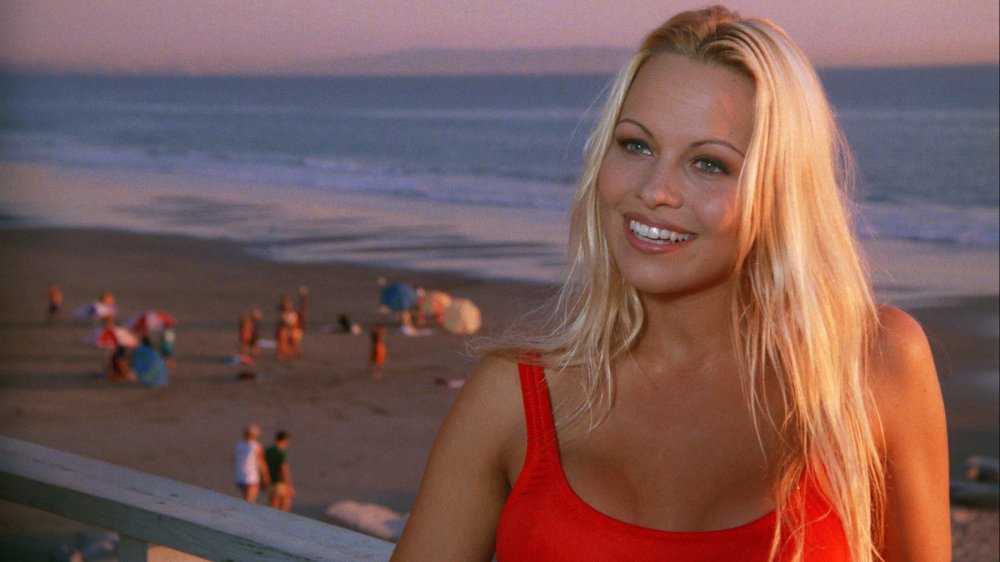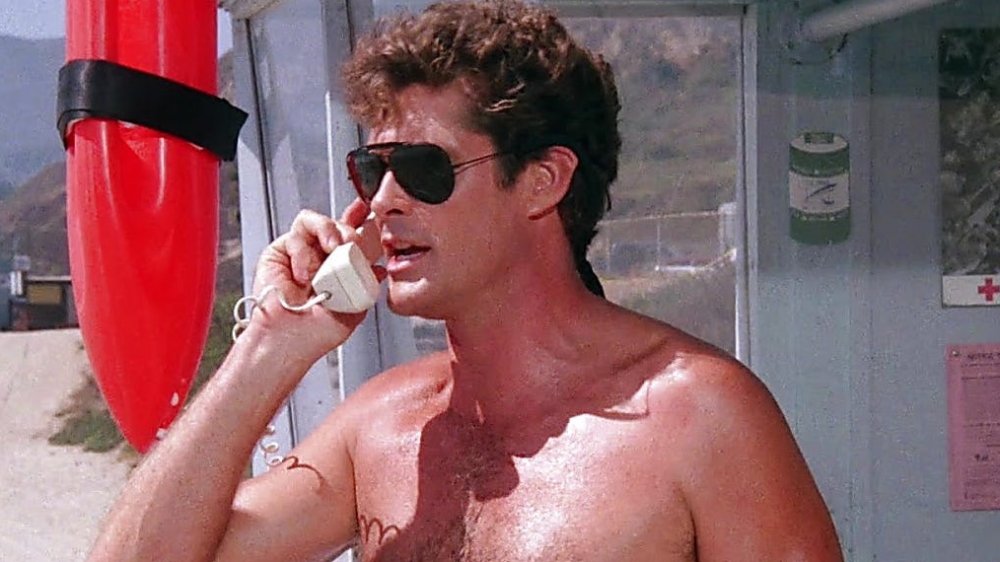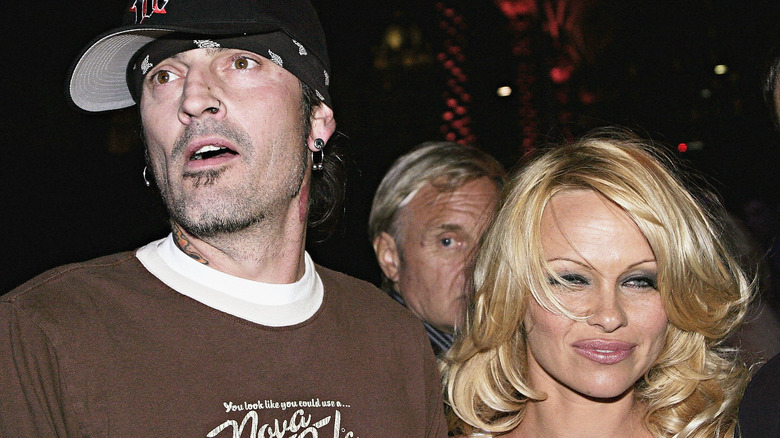The Inside Story Behind Baywatch, The TV Phenomena That Owned The '90s
Few things were as popular and far-reaching in the '90s than "Baywatch." For well over a decade, a sizable chunk of the planet tuned in weekly to experience the exploits of a team of Los Angeles area lifeguards who kept a well-traveled piece of beachfront safe. Part procedural drama, part thrilling action show, and several parts cheesy and titillating ogle-fest, "Baywatch" never underestimated the populist appeal of attractive people wearing very little, as well as the satisfying thrill of watching heroic people save lives. Perhaps the ultimate guilty pleasure, "Baywatch" aired every weekend on hundreds of stations across America and around the world, offering up predictable, formulaic, and wildly entertaining television and made household names (if not sex symbols) out of David Hasselhoff and Pamela Anderson.
"Baywatch" was one of the most successful and long-running shows in history, and it became a franchise, with multiple spinoff shows, TV movies, and even a semi-tongue in cheek feature film starring the Rock. Here's the inside story of one of the biggest and most universal phenomena in pop culture.
Nobody wanted Baywatch
One of the creators of "Baywatch," a show about lifeguards, worked as a lifeguard himself. Greg Bonann patrolled the beaches of Los Angeles County throughout the 1970s and 1980s. One day he mentioned to fellow lifeguard Michael Newman that their job could make for a compelling TV show. "He goes, 'If that show CHiPs could make it, we could make a show about lifeguarding,'" Newman recalled on E! True Hollywood Story.
Bonann unsuccessfully pitched his show for 10 years. Then in the late '80s, while still lifeguarding, Bonann rescued the children of Stu Erwin, an executive at MTM Enterprises, a TV production company run by Mary Tyler Moore and her husband Grant Tinker. Bonann pitched Erwin his series, and while Erwin passed, he helped the lifeguard refine his pitch. He went on to make sports videos, but then his sister married TV writer Douglas Schwartz, who, along with his writing partner Michael Berk, were hired at GTG, a new production company founded by Tinker in 1987. That pair didn't care for the lifeguard series either, until Schwartz attended something called the Lifeguard Games at Bonann's behest. That convinced him that there was a show in there somewhere, and with Berk, he developed a show called Baywatch and pitched it to CBS. That network said no, but NBC approved a two-hour TV movie (which would also serve as a pilot) called "Baywatch: Panic at Malibu Pier."
Baywatch briefly failed, disappeared, and was reborn
Airing in April 1989, the made-for-TV movie "Baywatch: Panic at Malibu Pier" ranked among the top 10 most popular shows of the week, leading NBC to order a "Baywatch" series set to debut that fall. Early "Baywatch" was less a breezy swimsuit spectacle and more of an '80s action drama, like "Simon and Simon" or "Riptide." Also unlike its '90s iteration, the first season of "Baywatch" wasn't that popular, finishing at No. 60 in the 1989-1990 Nielsen ratings, edged out by "My Two Dads" and "Father Dowling Mysteries." Ratings were bad, and the show's NBC run ended after a single season. "We didn't get canceled on NBC because of performance," cast member Billy Warlock told Esquire. "We just didn't have the money." Indeed, production company GTG closed up shop, leaving "Baywatch" in TV purgatory.
Around that time, European "Baywatch" distributor Freemantle asked for another season of episodes, telling producers that overseas demand for the show was strong. Co-creator Douglas Schwartz asked for advice from his uncle, "Brady Bunch" and "Gilligan's Island" creator Sherwood Schwartz. Having had major success syndicating reruns of those shows, he suggested the "Baywatch" team buy back the rights to their show from GTG, get a new production company, and enter into the lucrative syndicated TV market. Tinker sold them the rights, and by late 1991, "Baywatch" was ready to go all over again.
Baywatch cut a lot of corners
As a relatively unproven startup, and because per-episode budgets on first-run syndicated television dramas were nowhere near what network dramas were in the early 1990s, those first few seasons of "Baywatch" had to do things a lot cheaper than they had with NBC. Freemantle offered $300,000 an episode, banking in particular on the show's advertising revenue potential in Germany, where David Hasselhoff was a huge star of both television and music. U.K.-based TV network ITV threw in some money too, provided that "Baywatch" stay wholesome in very specific ways — no gun use and no depicting violent acts on women or children.
Still, producers had to cut costs. One huge line item was star David Hasselhoff's salary. He agreed to a 50 percent reduction in his acting fee in exchange for an executive producer credit, which made him eligible for a chunk of the profits should the show find lasting success. That was a smart move: According to Fox Business, Hasselhoff wound up earning about $100 million for his involvement in "Baywatch." Other, lesser-known stars of the show didn't make much, however, taking home per-episode paychecks in the $2,500 to $5,000 range.
Baywatch was extremely popular, and not for obvious reasons
Obviously "Baywatch" was a popular TV show — otherwise it wouldn't have run for more than 200 episodes over the course of more than a decade, launched the careers of multiple people, and inspired a movie of the same name. What is a little surprising is how staggeringly popular the show was at the peak of its run. By the mid-'90s, each episode was viewed by 1.1 billion people on average, across more than 142 countries, and translated into 15 languages besides English. With the world population around 5.77 billion at the time, that means roughly one in five people — worldwide — tuned into "Baywatch" on a regular basis. The reason it surpassed the previous most popular show, "Dallas," was the spread of satellite dishes.
Broken down into male and female viewers, one might assume that the bikini-clad show's audience was overwhelmingly male. According to the Los Angeles Times (via the Sun-Sentinel), about two-thirds of "Baywatch" viewers were women. The reason, according to co-creator Gregory J. Bonann, is that its female characters are "positive role models" who are "athletic, professional, intelligent, and able to make any rescue a man can make."
Baywatch owes much of its visual style to a blind man
"Baywatch" was never a critically acclaimed show, but it knew what it was, and it was fine with its place in the TV landscape as a source of eye candy and escapism. A near-constant stream of pretty people in skimpy outfits running on a beach made "Baywatch" memorable as a show slight in content but heavy on the visuals. Douglas Schwartz helped shape that aesthetic, both as a co-creator of the series and a director of 43 episodes and three made-for-TV "Baywatch" movies — and he's legally blind.
When he was 20, Schwartz received a diagnosis of retinitis pigmentosa, a degenerative condition that leads to extreme "tunnel vision." By the mid-'90s, he'd lost 90 percent of his vision. "My vision is 10 degrees; most people see 180 degrees," Schwartz told the The New York Times. "But everything I could see was in-camera." According to Schwartz, he's the only legally blind person to ever be admitted into the Directors Guild of America.
Baywatch, starring Sandra Bullock?
"Baywatch" made stars out of many up-and-coming performers, notably Pamela Anderson (as lifeguard C.J. Parker) and a pre-beard and pre-Aquaman Jason Momoa. But only a relative handful of actors (and the "right" ones at that, according to cast agents) could be a part of the show at any given time, leaving plenty of famous and talented people off the beach. "Scream" star Neve Campbell auditioned but didn't fit in, while future A-list star Sandra Bullock said no thanks and canceled a scheduled audition. "Desperate Housewives" star Teri Hatcher was almost cast, according to co-creator Michael Berk, while '90s pop singer and dancer Paula Abdul nearly replaced original cast member Erika Eleniak, ultimately losing the role of C.J. Parker to Pamela Anderson.
David Hasselhoff secured the lead role of lifeguard chief Mitch Buchannon, but he almost passed. The former "Knight Rider" leading man read the pilot script, and on first instinct rejected the role, recalling in his memoir "Don't Hassel the Hoff" that he told his agent at the time that it was "basically 'Knight Rider' in a bathing suit." He changed his mind and got the gig, after producers rejected other '80s TV stalwarts like Tom Wopat ("The Dukes of Hazzard"), Lorenzo Lamas ("Falcon Crest"), and William Katt ("The Greatest American Hero").
David Hasselhoff wasn't a Pamela Anderson fan
Jeremy Jackson portrayed Hobie Buchannon for nine "Baywatch" seasons, but he wasn't producers' first choice. He began his stretch at just nine years old, winding up with the role after another, slightly older actor had almost landed the part: 15-year-old Leonardo DiCaprio. "We actually had DiCaprio ready to be cast," co-creator Michael Berk told The Hollywood Reporter. What happened? Hasselhoff happened. Hobie Buchannon is the son of his "Baywatch" character, Mitch Buchannon, and Hasselhoff thought that if a teenager was portraying his son, it would make him seem substantially older than if a child were to take the part. "He had a lot of concerns of that type," co-creator Douglas Schwartz added.
Producers ignored Hasselhoff's concerns when they brought in Pamela Anderson — best known for her work on "Home Improvement" and in Playboy — in Season 2. Hasselhoff objected to Anderson's casting, feeling that "Baywatch" was a family show, and no place for a woman who'd appeared nude in the pages of a magazine. He also thought Anderson could be, well, distracting. "She had these enormous breasts," Schwartz said, "and David thought he would be upstaged by everyone looking at her breasts. Which is what happened."
This story told in slow motion
Apart from Playboy models in red swimsuits, the most memorable images from Baywatch are its countless slow-motion shots of heroic lifeguards or women in bikinis running across the sand at a languid pace to a soft rock soundtrack. By the time Baywatch went into production in the late 1980s, the influence of Chariots of Fire was still being felt. The Oscar-winning movie from 1982 featured lots of slowed-down running shots, and was parodied throughout the decade (memorably in National Lampoon's Vacation). According to Baywatch star David Hasselhoff in his memoir Don't Hassel the Hoff, it influenced co-creator Greg Bonann, too. "Greg had just gotten back from shooting the Olympics" in 1988, particularly "sprinters in the 100-yard dash in slow motion," co-creator Michael Berk told Esquire. A stylistic choice for sure, but it was also a practical measure and a cost-saving technique for producers. "They'd say to the second unit crew: 'We're five minutes short — go shoot another montage,'" Hasselhoff wrote. "Grab the most beautiful extra you can see and shoot her running down the beach in slow motion."
The cast came in, the cast went out
Over its 11 seasons and more than 240 episodes, more than 50 actors were a part of the main cast of "Baywatch," portraying lifeguards and love interests and such. That makes for one of the biggest casts in TV history, and that's partially because the show was in production for so long — actor substitutions keep a show fresh — but there were plenty of other reasons for the show's revolving door-like personnel changes. Co-creator Douglas Schwartz said that sometimes people made it into the show because of their agreeable appearance. "Carmen Electra, Traci Bingham, and Michael Bergin were all examples of that," Schwartz told Esquire. "They would look good in a swimsuit, they can do the action, they could swim. They just, as actors, were not strong enough, so we wouldn't give them big storylines," leading to relatively brief tenures.
Yasmine Bleeth "was doing drugs at the time," the producer said, and when she started "not showing up and having difficulties," "Baywatch" parted ways with her. Electra quit because "she didn't feel" the show was right for her. Pamela Anderson walked away, too, to focus on her family after giving birth to her second child.
Baywatch made its cast sick
"Baywatch" shot primarily on location — on real California beaches with all of their benefits and risks. The pilot movie, "Baywatch: Panic at Malibu Pier," filmed in early January 1989, when the water off the coast of Malibu was a chilly if not dangerous 49 degrees. Even worse, according to David Hasselhoff in his memoir, the water was loaded with garbage, feces, and hypodermic needles. Production was halted and moved to Hawaii when cast members contracted a stomach virus.
The first episode of the "Baywatch" series was filmed on Will Rogers State Beach in Pacific Palisades, California, and the ocean wasn't as clear and refreshing as it looked on TV. The water remained, according to Hasselhoff, "still filthy," and in order to prevent cast members from getting extremely sick from various pollutants, they "were doused in disinfectant by medics every time we came out of the water."
Tommy Lee wasn't a big Baywatch fan
According to David Hasselhoff's autobiography "Don't Hassel the Hoff," "Baywatch" producers saw about 40 hopefuls for the role of C.J. Parker, eventually hiring Pamela Anderson. She happened to be dating cast member David Charvet, something "Baywatch" co-creator and producer Michael Berk said he wasn't aware of at the time. The couple eventually broke up, and Anderson eloped with Motley Crüe drummer Tommy Lee in 1995, the first milestone in their tumultuous, tabloid-friendly relationship. Charvet, meanwhile, left the show in 1996, but not before a romantic, onscreen, kiss-filled goodbye between his character and hers. That scene filmed on a day when Lee happened to be visiting the "Baywatch" set. He didn't handle it well. "He was so upset that Pamela was kissing David Charvet that he destroyed Pamela's dressing room — kicked in the door, smashed her mirrors and her windows and things like that," co-creator Douglas Schwartz told Esquire. "We had to have security escort him off the set and then he was barred from ever coming on the set again."
In 1996, Lee and Anderson's extraordinarily explicit homemade video leaked to the public. According to The New York Times, representatives of many outlets that aired "Baywatch" called for Anderson's removal from the series, and producers were worried about losing ad revenue, or that the show could be canceled. The opposite happened: In the aftermath of the sex tape, "Baywatch" scored its highest ratings ever.
Baywatch Down Under was dead in the water
After nine seasons, "Baywatch" started getting a bit stale, so in 1999 it rebooted itself as "Baywatch Hawaii," moving both the setting and shooting to beautiful Hawaii. The move was moderately successful, with producers squeezing two more seasons out of the aging franchise. Who knows if it would've lasted even longer had the original plan to make "Baywatch Down Under" not fallen apart. At the time, it was cheaper to film in Australia than California, according to News.com, and "Baywatch" sought to take advantage of the lower production costs, filming a two-part episode at the Avalon Beach Surf Club in Sydney as a tryout before making a permanent move.
Local residents strongly objected after members of the production overstepped their bounds, allegedly escorting a surfer off the beach and forcing out noisy skateboarding teens. Area citizens also feared that in the future they'd have diminished access to the beach, nor did they want to deal with the possibility of looky-loo tourists. "Baywatch" producers also demanded $200,000 from the Australian government to offset costs, arguing that the show would ultimately add $18 million annually to the local economy. After more than 1,700 residents showed up for a heated public hearing on the matter, the production backed off on its long-term plans, but only after a contingent from Hawaii offered a better deal.
Behind the music of Baywatch
When "Baywatch" first dropped on NBC in 1989, it didn't yet have its recognizable theme song. The pilot/made-for-TV movie "Baywatch: Panic at Malibu Pier" used Kim Carnes' country-rock tune "Above the Waterline" for its opening credits sequence. When "Baywatch" aired as an episodic series, producers chose former Chicago singer Peter Cetera's "Save Me" for the opening sequence. "Baywatch" entered first-run syndication in 1991, which is when it got its far more familiar theme song "I'm Always Here."
"I'm Always Here" was co-written by its performer Jimi Jamison, the mid-1980s-era replacement lead vocalist in the arena rock band Survivor. Jamison had just split from Survivor and was recording his first solo record when "Baywatch" producers asked him to compose and perform the song, for which he made a music video. "I'm very proud of the song which I wrote with Cory Lyrios and of the TV show for making it in the Guinness Book as the most watched show in history," Jamison told Rediscover the 80s. "We always get a huge reaction whenever we perform the song live. It's really a good feeling."
For many years, a song called "I Believe" played over the end credits of "Baywatch," credited to soft rock star Laura Branigan and the show's lead actor David Hasselhoff. It was released as a single in Germany, where Hasselhoff was known just as much for his music as he was for his acting at the time. His 1989 single "Looking for Freedom" was a number one hit in Germany, Austria, and Switzerland.
The brief and strange life of Baywatch Nights
Back in the '90s, it was almost routine for successful TV shows to get a spinoff, and "Baywatch" was no exception. In 1995, "Baywatch Nights" joined its parent series in syndication. David Hasselhoff did double duty, playing Mitch Buchannon on both shows. He served as a California lifeguard in the daytime, and then literally moonlighted as a private investigator at night. "Baywatch" police officer Garner Ellerbee (Gregory Alan Williams) also made the jump to "Baywatch Nights," which starred Angie Harmon as a former New York detective named Ryan McBride and soul singer Lou Rawls (who performed the show's sultry theme song). "Baywatch" lifeguard Donna Marco (Donna D'Errico) joined the "Nights" staff halfway through Season 1 in a bit of a soft reboot before the show completely changed its format in Season 2.
Abandoning its standard detective show plots, "Baywatch Nights" suddenly (and quite inexplicably) became a rip off of "The X-Files," with the lifeguards investigating aliens, ghosts, and other paranormal occurrences. "The producers were losing money and decided to bring in David Gerber, who was executive producer on 'Police Story,' to change the format of the show," David Hasselhoff told Bristol Bad Film Club. "As a result, it became more like 'Police Story,' which was really boring to us, so we decided to go the supernatural way, because we all loved 'The X-Files,' and investigate weird-ass crimes." Unsurprisingly, not enough people tuned in to watch "Baywatch Nights," and it was canceled after just two seasons on the air.
It took more than a decade to make a Baywatch movie
Remembered as a distinctly '90s phenomenon, "Baywatch" evolved into "Baywatch Hawaii" and the TV franchise aired its last episodes in 2001. Just three years later, a revival was already in play, but as a feature film. According to The New York Times, DreamWorks bought the rights in 2004 and never put anything into production, eventually ceding the project to Paramount. Several more years went by before the cameras rolled on the "Baywatch" movie — Paramount executives ordered a slew of screenplays because none they saw could nail what they were looking for, which was a movie that would honor the "Baywatch" series but also gently make fun of it.
In 2014, a decade after discussions began, Paramount officially ordered "Baywatch" into production, contingent upon the casting of Dwayne "The Rock" Johnson. The final film has traces of several different screenplays (it credits nine writers, including "Reno 911" creators Thomas Lennon and Robert Ben Garant). Original "Baywatch" star David Hasselhoff made a meta cameo as a lifeguarding mentor, and, like the TV show, "Baywatch" the film was much more popular outside the U.S. than inside it: It earned $58 million at the North American box office and $120 million everywhere else.
COVID-19 derailed a Baywatch reboot
A great many fondly remembered and heavily watched television shows of the 1990s were rebooted in the 2010s and 2020s, among them "Roseanne," "Charmed," "Boy Meets World," "Gilmore Girls," "The X-Files," "Twin Peaks," and "Full House." One would think that the most globally popular show — the one that averaged more than a billion weekly viewers at its peak, per The New York Times — would be ripe for a revival. That new "Baywatch" hasn't transpired, but it wasn't for a lack of trying on the part of producers.
"Right before COVID, they were in talks of rebooting the show," original series cast member David Chokachi told The Production Meeting Podcast (via TooFab). "They were going to bring back three of the regulars from the original and I'm one of them, I found out, which is cool." The pandemic seems to have stifled progress on the new "Baywatch," which almost happened back in the 2010s, but another project got in the way. Chokachi said he urged producers to get going when the first wave of reboots hit the air, but then "Baywatch" arrived in multiplexes in 2017. "The movie came out and the movie squashed any idea. CBS was going to do the show." Chokachi even helped CBS representatives scout locations, only for the network to opt to make the "Magnum, P.I." reboot instead.
















